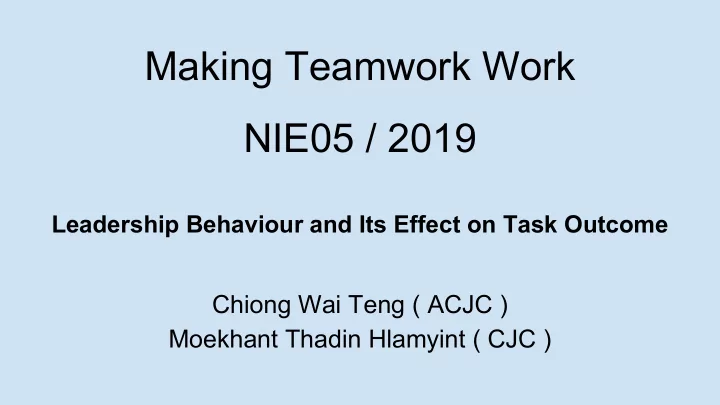

Making Teamwork Work NIE05 / 2019 Leadership Behaviour and Its Effect on Task Outcome Chiong Wai Teng ( ACJC ) Moekhant Thadin Hlamyint ( CJC )
● Research Question ● Literature Review ● Methodology ● Findings ● Conclusion
Research Question “Does having team members who exhibit leadership behaviour produce better results?”
Literature Review Case study of characteristics of effective leadership in graduate student collaborative work A factor Analysis on Teamwork Performance -an Empirical Study of Inter-instituted Collaboration
Case study of effective leadership in graduate student collaborative work Lessons learned: Narrowed our scope in terms of the traits to look for. Characteristics of effective leaders ● Interpersonal skills ● Group management ● Time management
A factor Analysis on Teamwork Performance -an Empirical Study of Inter-instituted Collaboration Purpose: Knowledge Sharing, Team Conflict and Emotional Intelligence and the roles they play: ● how they affected teamwork ● their relationship with each other
Results: ● Emotional intelligence created a significantly positive effect on knowledge-sharing ● Emotional intelligence created a significantly negative effect on team conflict ● The effect of emotional intelligence on team performance was not significant. ● The relationship between knowledge-sharing and team performance was significantly and positively related
Context ● Chatlogs from 9 teams of 3 to 4 secondary school students ● Discuss and come to a final answer on 2 team collaborative problem solving task on an online chat ● Data collected as part of a larger project which involves a formative assessment of teamwork in team tasks in a Secondary school.
Method Chatlog analysis method Leadership behaviour dimensions Social Assertiveness (S) - Quantitative content analysis by coding for each line that exhibits social 1. ability to initiate and maintain social assertiveness and/or task directiveness interactions easily (Lorr, More, & Mansueto, 1981) 2. support team members emotionally and - Other coding procedures psychologically (Bennett & Kane, 2014; Drach-Zahavy & 1. Messages after the “ <Final Answer> “ Somech, 2002; Sargent & Sue-Chan, 2001) were not coded for. Task Directiveness (T) 2. code all lines which exhibit S and T regardless of spam and typos. For example, 1. disposition to lead, direct, or to influence “good jo” followed by “good job”. others (Lorr et al., 1981) 3. Allow double coding. For example “PAC 2. time management: meeting deadlines and showing awareness of time constraints (Duemer WRITE THE FINAL ANS :)” can be coded for et al., 2004) both S and T.
Method Level of response mark scheme (LORMS) Final Answers were measured by LORMS Requirements L4 - Answers all of the requirements Where the Task Requirements (highest - Must provide a well elaborated reasoning of the are, score) decision 1. Identify the problem. - Full consideration of all parties affected 2. What will be the best L3 - Answers all of the requirements possible solution to solve - Provides little explanation / logical reasoning of the problem? the decision 3. Please explain how you - Some consideration of parties affected reached your decision. L2 - Answers any two out of the requirements - Attempts reasoning but rather shallow L1 - Answers only one of the requirements - No reasoning provided adapted from the New Jersey Open-Ended Scoring Rubrics.
Leadership dimensions and results at the individual members level - Increasing count of S (Red), T (Green) as task score (Blue) increases - Trendline shows an increasing trend
Leadership dimensions and results at the individual members level - No significant general trend - S (Blue) is decreasing while T (Red) shows slight increase - General trendline is relatively constant among all individuals
Leadership dimensions and results at the team level - Count of T shows increasing trend - Count of S shows slight increase - Overall trend is increasing
Leadership dimensions and results at the team level - Significant increase of T from teams that scored L1 to teams that scored L4 - S shows decreasing trendline - Overall trendline (Yellow) shows increasing trend T contributes greatly to the overall trendline!
Conclusion ● Insufficient evidence to show that our hypothesis is valid at the individual level as the trends for S and T do not show any significant increase or decrease. ●However, at the team level, teams that exhibited greater leadership dimensions produced better results . ●Hence, team behaviours such as communication, coordination, and cooperation are more evident in team discussions. Limitations of study 1. Small sample size 2. Quantitative coding may have caused us to lose information due to oversimplification 3. Leadership dimensions may have leaned towards team behaviour
Recommendations - Research on leadership behaviours that lean less towards team behaviours - Studying team behaviours that facilitate better leadership and teamwork - Research on whether there are certain words on the online platform that will lead to better leadership and teamwork
Acknowledgements Thank you Dr Elizabeth Koh for guiding us throughout the research period!
Recommend
More recommend